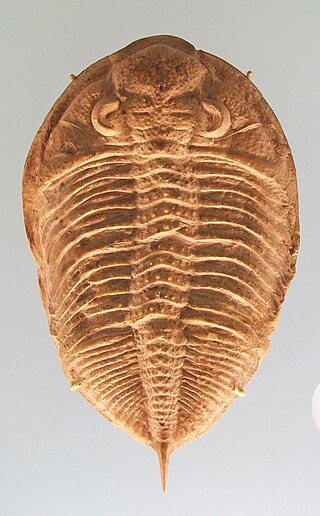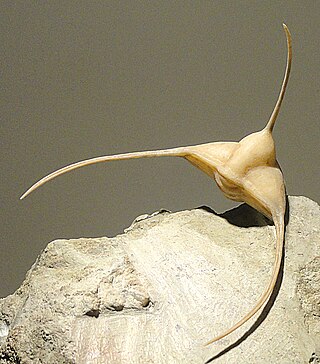
Trilobites are extinct marine arthropods that form the class Trilobita. Trilobites form one of the earliest known groups of arthropods. The first appearance of trilobites in the fossil record defines the base of the Atdabanian stage of the Early Cambrian period and they flourished throughout the lower Paleozoic before slipping into a long decline, when, during the Devonian, all trilobite orders except the Proetida died out. The last trilobites disappeared in the mass extinction at the end of the Permian about 251.9 million years ago. Trilobites were among the most successful of all early animals, existing in oceans for almost 270 million years, with over 22,000 species having been described.

The Furongian is the fourth and final epoch and series of the Cambrian. It lasted from 497 to 486.85 million years ago. It succeeds the Miaolingian series of the Cambrian and precedes the Lower Ordovician Tremadocian Stage. It is subdivided into three stages: the Paibian, Jiangshanian and the unnamed 10th stage of the Cambrian.

Trimerus is an extinct genus of trilobite in the family Homalonotidae. Trimerus is one of North America's largest trilobites, reaching over 20 cm (7.9 in) in length. It had a thorax composed of 13 segments with weak trilobation, a large subtriangular head terminating in an expanded rostral plate, a two-pronged hypostome, and a triangular pygidium. It is known from all continents except for Antarctica. Its tiny compound eyes and the shovel-like anterior of the head suggests a burrowing lifestyle, and an exoskeleton marked with many small pores which, in life, probably housed hair-like sensory setae in life, allowed the trilobite to feel which portions of its body were covered with sediment.

Arachnomorpha is a proposed subdivision or clade of Arthropoda, comprising the group formed by the trilobites and their close relatives (Artiopoda), Megacheira and chelicerates. Under this proposed classification scheme, Arachnomorpha is considered the sister group to Mandibulata.

Greenops is a mid-sized Devonian trilobite of the order Phacopida, subfamily Asteropyginae. They are mainly reported from the mid-Devonian Hamilton Group of upstate New York and southwestern Ontario. A similar-looking trilobite from Morocco is often mis-labelled Greenops. Greenops had schizocroidal eyes, large genal spines and short, sharp spines at the tip of each segment of the pygidium ("tail"). Greenops lived in warm, fairly deep water. In the Hamilton Group of New York, they are found with Eldredgeops, Dipleura and Bellacartwrightia, a trilobite that resembles Greenops but has much larger pygidial spines. In Ontario, they are found in the Widder Formation, which outcrops at Arkona, where they are, by far, the dominant trilobite.
Fremontella is an extinct genus from a well-known class of fossil marine arthropods, the trilobites. It lived during the part of the Toyonian stage. This faunal stage was part of the Cambrian Period. Fremontella shares with the other genera of the Bristoliinae subfamily, Lochmanolenellus and Bristolia conspicuous and long curved spines on the headshield. These reach back equal to 4-5 thorax segments. The furrows that separate border, eye ridges, glabella and its lobes are distinct. The area outside of the axis of the third segment of the thorax is enlarged, and carries large trailing spine on each side.

Glyptambon is an extinct genus of Silurian trilobite in the order Phacopida. It is a member of the family Dalmanitidae and the subfamily Dalmanitinae, although it has been classified in the related Ordovician subfamily Mucronaspidinae. The type species G. verrucosus was previously placed in Dalmania and later in Dalmanites. Because this species was considered distinct from other Dalmania and Dalmanites species, the new genus Glyptambon was erected for it in 1981.G. amsdeni and G. gassi were named in 1991 from Tennessee and Illinois, respectively.

Aayemenaytcheia paragranulata is a Middle Devonian proetid trilobite.

Fallotaspis is a genus of redlichiid trilobites found in Early Cambrian-aged strata of the United States and Morocco.

Proetidae is a family of proetid trilobites. The first species appeared in the Upper Ordovician, and the last genera survived until the Middle Permian. However, if the closely related family Phillipsiidae is actually a subfamily of Proetidae, then the proetids of Proetidae survive until the end of the Permian, where the last perish during the Permian–Triassic extinction event.

Holmiidae is a family of trilobites, that lived during the Lower Cambrian (Atdabanian). The Holmiidae is a diverse family of eight genera containing at least 17 species. It includes some of the earliest trilobites of Baltica. Holmiidae occur throughout Baltica and Western Laurentia, and also in Morocco.

Phillipsiidae is a family of proetid trilobites, the various genera of which comprise some of the last of the trilobites, with a range that extended from the Kinderhookian epoch of the Lower Mississippian, to the end of Changhsingian age at Permian-Triassic extinction event in the latest Permian period.

The Biceratopsinae is an extinct subfamily of redlichiid trilobites within the family Biceratopsidae, with species of small to average size. Species belonging to this subfamily lived during the Toyonian stage, 516-513 million years ago, in the former continent of Laurentia, including what are today the South-Western United States and Canada.
Mesolenellus is an extinct genus of trilobites that lived during the lower Cambrian (Botomian), found in Greenland and Spitsbergen.

The Bristoliinae is an extinct subfamily of trilobites, fossil marine arthropods, with species of small to average size. Species belonging to this subfamily lived during the Botomian and Toyonian stage (Olenellus-zone), 522-513 million years ago, in the former continent of Laurentia, including what are today Mexico, the Appalachian Mountains and the south-western United States, and Canada.

The ”Fallotaspidoidea” are a superfamily of trilobites, a group of extinct marine arthropods. It lived during the Lower Cambrian (Atdabanian) and species occurred on all paleocontinents except for the Gondwana heartland. A member of this group, Profallotaspis jakutensis, has long been the earliest known trilobite, but recently the redlichiid Lemdadella has been claimed as occurring even earlier.

Cyclopygidae is a family of asaphid trilobites from the Ordovician. Cyclopygids had an extratropical distribution, and there is evidence that they lived in darker parts of the water column. Cyclopygids are characterized by enlarged eyes, with a wide angle of view, both horizontal and vertical, reminiscent of the eyes of dragonflies. These typically touch the glabella directly on the side. Cyclopygids all lack genal spines, but Symphysops carries a forward directed frontal spine on the glabella. It is presumed that at least the members of the genus Pricyclopyge swam upside down and had bioluminescent organs on the third thorax segment. Cyclopygids had between 7 and 5 thorax segments, a wide and stout axis, and short side lobes.

Raphiophoridae is a family of small to average-sized trilobites that first occurred at the start of the Ordovician and became extinct at the end of the Middle Silurian.

Proetus is a genus of proetid trilobite found in Silurian-aged marine strata of Europe.
This list of fossil arthropods described in 2009 is a list of new taxa of trilobites, fossil insects, crustaceans, arachnids and other fossil arthropods that have been described during the year 2009, as well as other significant discoveries and events related to arthropod paleontology that occurred.















